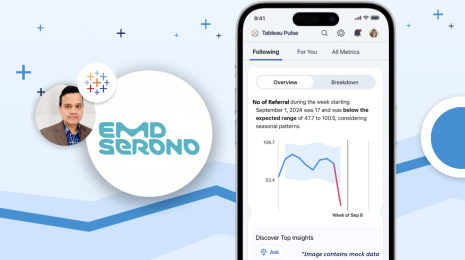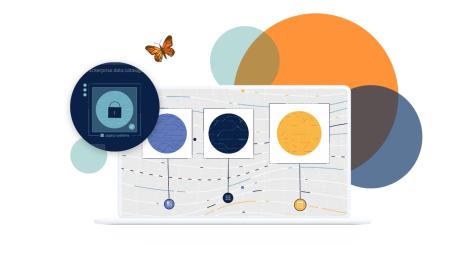Data diaries: Defining a culture of self-service analytics

Note: Data Diaries is an occasional series that explores the makings of a culture of analytics.
Why should you adopt a culture of self-service analytics? Simply put, it makes for happier, more productive, more results-driven people.
Classic economic theory suggests we are one-dimensional, money-driven, extrinsically-motivated creatures. We move toward pleasure and away from pain, the theory says. This belief, which Daniel Pink calls the Human Operating System 2.0, has been the bedrock of management practice since industrialization.
But it turns out money isn’t enough to bring out our best. As the famous psychologist Abraham Manslow observed, we’re ultimately drawn to activities that align with our human nature, which is fundamentally striving. What keep us engaged are continuous challenges that provide opportunities for creativity and achievement.
In the modern workplace, the world’s ever-growing volume of data can provide opportunities for discovery and achievement—but only if we know how to see and understand the data. And that’s where a culture of self-service analytics comes in.
In this culture, the facts prevail
So what, exactly, is this culture of self-service analytics? In short, it’s a culture in which data plays a central role in every major conversation. Everyone has the ability to ask and answer questions of their data. The entire organization subscribes to a data-based truth, and facts drive decisions.
But that doesn’t mean the truth is dictated within this culture; instead, everyone is empowered to explore that truth independently and share findings with others. Sure, people may disagree from time to time, but when they do, facts, not opinions, have the final say. It’s as Peter Scholtes said in The Leader’s Handbook: “Without data, opinion prevails. Where opinion prevails, whoever has power is king.”
How to build a culture of self-service analytics
Before you can start building this culture, you first have to set the cornerstones. Articulate and subscribe to a set of values that will help anchor the practices you want to adopt. One might be that you believe in the power of the individual. Another might be that your decisions are based on facts and critical thinking.
You might be tempted to adopt new practices first then see which values result, but that’s a topsy-turvy approach. You need guiding practices to light the path, or you might get lost along the way.
Step 1: Empower every person
Our curiosity is innate. When we encounter something new, we want to know more. We also possess a need to know. Knowledge is rewarding because it “dispels undesirable states of ignorance and uncertainty,” says researcher Jordan Litman. It freaks us out that we can’t figure out why something happened—why a certain crash took place, for example.
Both feelings, the want and the need to know, drive us to understand, and that’s powerful. And that brings us to the fundamental building block of this culture of self-service analytics: The person with the question of the data has the capacity to ask and answer that question. That means every team has access to data (with appropriate governance) as well as an intuitive analytics tool to make sense of the numbers. Every person is empowered.
Organizations that don’t embody this culture typically rely on a few people to ask and answer questions for the entire company. They might have a system in which business users send their questions to the IT team and request a static report. Business users might have to wait weeks or months for an answer, and if they have a follow-up question, they’d have to start the process all over again.
The culture of analytics functions around the empowerment of the person with the question. That means in addition to data and analytics tools, every worker needs to know how to analyze the data. Empower people with a visual self-service analytics tool that requires no coding knowledge. And provide continuous encouragement through a nurturing program that provides one-on-one help to anyone who needs it.
Step 2: Encourage participation
Have you ever seen a scientific paper with a single metric or equation on it? Your answer is probably no, and that’s because we want and need to know why something is. We need to be convinced why a certain action is the best option, especially when the stakes are high. Scientific papers are quite long because they must explain methods and present data in a manner that builds consensus.
What if useful facts simply showed up in a manila envelope one day? How would your team feel carrying out an action plan based on those facts?
When we can be a part of the discovery process, we are generally happier and more engaged. When we can express our opinion and exercise judgment, we participate and persevere. And once team members have the power to participate, leaders can set the tone. Leaders can begin conversations by sharing what the data shows, or elevate conversations by asking which data compelled a certain conclusion. Such examples signal to others that they, too, must frame discussions around data.
Data democracy increases the number and the quality of conversations about strategy and operations. This ultimately results in higher-quality decisions with more support for execution.
What results from a culture of self-service analytics
Autonomy is a natural inclination. When we have real control over various aspects of our work, we are much more satisfied. We enjoy the thrill of progress when performing tasks.
What we’re after is a state of flow, says Mihaly Csikszentmihalyi. The researcher was fascinated with the ecstatic state of artists and athletes. How did they get lost in the moment? Why were they willing to devote so much time to a pursuits that may not pay off financially?
Mihaly’s interviews discovered common aspects of peak experiences. His subjects described a subconscious energy like “water carrying them along,” so he called the state “flow.” Flow activities were fun because they offered the right amount of challenge. Activities that were too easy produced apathy while those that were too hard triggered anxiety. The most enjoyable activities were well-matched to the person’s ability. These were the Goldilocks tasks.
Tasks that produced flow offered immediate feedback and clear indicators of progress. During these activities, worry about failure and self-consciousness disappeared. Challenge led to growth and, eventually, mastery. Participants found their progress incredibly satisfying.
Empowering individuals to explore data helps them connect to a purpose larger than themselves. Being able to provide great customer service or effecting positive change in the world are examples of purpose-aligned work. Knowing how the organization is tracking toward its purpose is extremely rewarding.
Seeing a premade chart during the last mile of a project doesn’t produce the same emotional engagement. Intrinsic reward comes from using data throughout the process to make educated decisions and measure progress along the way. This approach incrementally liberates suppressed energy, which has a viscerally powerful effect.
And that’s good news for the organization as well. Engagement not only helps make for happier teams but also makes for more productive people and, ultimately, a better bottom line.
We all want to work at a place where we can exercise our creativity and strive to make a difference. With a culture of self-service analytics, organizations can use data to reach higher levels of knowledge, engagement, and imaginative thinking.








